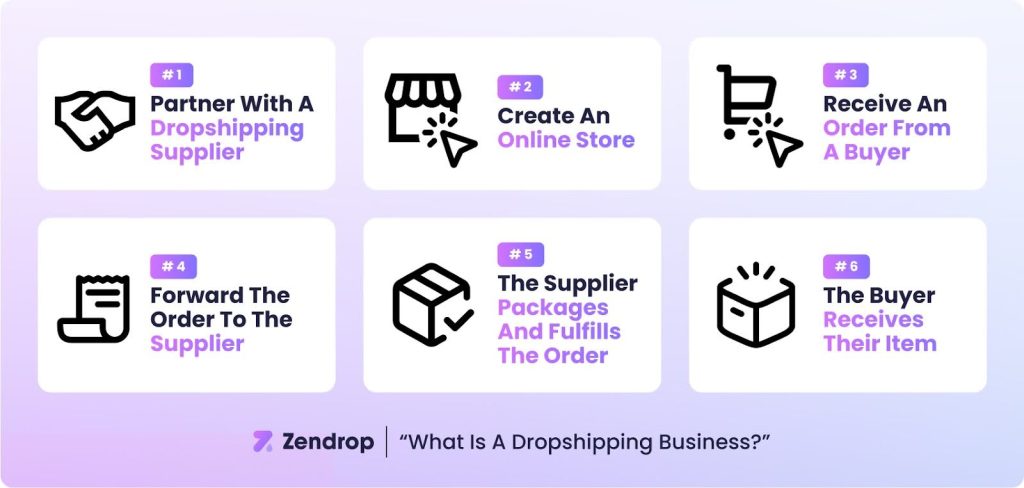
Dropshipping involves acting as an intermediary between product suppliers and end users. You’ll obtain products from suppliers and ship them to customers without maintaining physical inventory. The supplier handles the packaging and shipment while you focus primarily on marketing.
The dropshipping model has become very popular because of its convenience. Yet, it’s not as easy as many imply. Building a loyal customer base and succeeding as a dropshipper takes considerable effort. This guide will help you learn how to make money dropshipping.

Dropshipping allows you to sell products without maintaining inventory. In this model, you’ll outsource order processing and shipment to a third party while focusing on promoting products to the right audience.
Dropshippers sell products from third-party suppliers at significant markups. For instance, if a supplier charges $20 for a product, you can list it for $30. When someone orders the product, the supplier ships it to them.
After paying $20 to the supplier and, let’s say, $2 for shipping, the remaining $8 is your gross profit. Repeat this process often, and your dropshipping business will earn healthy profits.
The main advantages of dropshipping are low startup costs and eliminating inventory-keeping headaches. Since you don’t need to invest in physical inventory to start a dropshipping business, the cost of entry is much lower than for conventional e-commerce businesses.
Anyone can start a dropshipping business for less than $100. The main costs are marketing and platform fees, which vary depending on the e-commerce software provider. Many entrepreneurs have flocked to the dropshipping model because of its convenience and low barriers to entry.
The key to successful dropshipping is finding reliable suppliers with high-quality products and industry-leading shipping. Zendrop fits this profile, as we offer diverse, high-quality products at competitive prices and ship products quickly.
Dropshipping can be a lucrative business model. However, it depends on several factors, including your product niche, pricing, suppliers, and marketing strategies.
On average, dropshippers mark up product prices from 15% to 20%. This markup ensures they have profits left after paying the supplier. However, some products can be marked up as high as 50% to 100%.
Some product niches tolerate higher markups than others. These are usually niches where customers’ decisions rely heavily on branding, making them willing to pay high prices for their favorite products. Cosmetics and jewelry are examples of these niches.
The keys to profitable dropshipping are building a distinct brand and having a unique value proposition. Social media marketing can help you build a premium brand and convince customers to pay more for your products than the competition.
A unique value proposition convinces people to buy your product, usually by focusing on the problems the product solves.
Suppose you want to sell office chairs. You can highlight that ergonomic office chairs reduce back pain and boost long-term productivity. This proposition convinces people that your office chair is not just for aesthetics, but also solves a crucial problem.
“How do dropshippers make money?” is a question many ask. The answer is “gradually and step-by-step.” Below, we’ll dive into how to make money from dropshipping.
Successful dropshipping starts with choosing a vibrant niche with a large customer base. Many people choose a niche they’re passionate about, as their knowledge of this niche helps them promote products effectively. However, choosing a niche isn’t all about passion.
Conduct extensive research about a niche’s existing size and prospects. Check data providers like Statista and read news articles, research papers, and surveys to evaluate if your desired niche is growing significantly. You might be passionate about a niche but discover bleak prospects. It’s a sign to choose an alternative niche despite your passion.
Demand is key to choosing a niche. Rising demand means more opportunities to attract new customers and build a loyal following while falling or stagnant demand means fewer opportunities.
You can analyze market demand via Google Trends, a free research tool from the world’s most popular search engine. This tool lets you monitor search queries for specific keywords over time. As the world’s leading search engine, search queries on Google mirror consumer interest in the real world.
Suppose you want to sell eco-friendly products. You can type “eco-friendly products” into Google Trends and monitor search interest over two decades. To demonstrate, we requested search insights over the past five years and got the chart below.

The chart indicates growing interest in eco-friendly products, mirroring increasing consumer demand. This growing demand presents opportunities for dropshippers to capture a new customer base.
Another tool is Meta’s Audience Insights, which aggregates user information from Facebook, Instagram, and WhatsApp. As the owner of three massive social apps, Meta provides valuable information about interest in specific niches.
Suppose you want to sell cosmetics. You can type "cosmetics" or related keywords into Audience Insights, showing you the number of active monthly users interested in this niche.
You can monitor interest over specific periods and the locations from which they originated. This information lets you determine whether your niche has a growing interest and which locations to target customers.
Online retailers like Amazon, eBay, and Walmart are also good research tools. As the leading global e-commerce companies, their demand trends mirror global demand. The best-selling products on these marketplaces also sell well on dropshipping sites.
Suppliers make or break your dropshipping business. Hence, seek suppliers with durable, high-quality products and fast shipping times. Durable products keep customers satisfied and anticipating more goods from you. Fast shipping times also make customers happy, increasing the chances of getting repeat sales.
AliExpress is a common platform dropshippers use to find suppliers. This massive online marketplace features millions of suppliers across different niches. You can install an AliExpress dropshipping plugin and seamlessly import products from this marketplace into your store.
Suppose a product retails for $10 on AliExpress. You can sell it for $15 to $20 and keep the rest as profit. The drawback is that AliExpress has all kinds of suppliers, including the good, bad, and the ugly.
Many AliExpress suppliers sell shoddy products with unbearably long shipping times, so it takes considerable effort to sift through the platform for the right ones.
Zendrop is another reliable platform for dropshippers to find suppliers. We directly manage our supply chain to guarantee product quality, unlike some platforms that connect dropshippers to random suppliers. Zendrop offers industry-leading shipping, ensuring customers receive goods quickly.
Before committing to any supplier, research their history and read reviews from dropshippers who’ve previously worked with them. If you observe many complaints regarding product quality, shipping, and customer service, it’s a signal to find an alternative supplier.
With your niche and supplier ready, the next step is to build your online store. This step may sound complicated, but it isn’t, thanks to e-commerce platforms like Shopify, WooCommerce, and BigCommerce. These platforms handle the complex backend aspects, allowing entrepreneurs to focus more on design and marketing.
Shopify is the most popular e-commerce platform, but you can still use many alternatives. Entrepreneurs prefer Shopify because of its user-friendliness and extensive third-party integration. It provides the backend infrastructure to list products, categorize them, and receive payments from customers.

Shopify is a ubiquitous e-commerce platform with many features. It’s the top choice for entrepreneurs who want to quickly set up dropshipping stores.
Source: Shopify
You can install your supplier’s app from Shopify’s App Store and import products seamlessly into your store. For example, Zendrop offers a Shopify app for online sellers. This app lets you import Zendrop products at the click of a button. When someone orders an item from your store, the details will be automatically sent to Zendrop for fulfillment.
User-friendliness is a crucial consideration when building your store. Illustrate your products with high-quality images and compress them to reduce load time and improve site speed.
Over 60% of traffic comes from mobile devices, so mobile responsiveness is critical for your store. Every visual element in your store should automatically adjust for mobile screens, ensuring visitors interact with your store as usual. The good news is that most e-commerce platforms handle this aspect for you.
Promotion is vital to learning how to make money with dropshipping. This business model is intensely competitive because of its low barriers to entry. Hence, you need an effective marketing strategy to differentiate your brand from competitors.
You can promote products via many mediums, including social media, search engines, and blogs. The key is targeting the right audience and having a unique selling proposition for potential customers.
Social media platforms like Facebook, Instagram, and X (formerly Twitter) have billions of users, making them effective marketing tools. These platforms allow you to create targeted ads, choosing the exact location, age range, and interests of the users who will see your ads.
Suppose you’re dropshipping gaming accessories. You can run Instagram ads targeting males aged 18 to 34 who are located in the U.S. and interested in gaming. Instagram algorithms will show your ads to this audience, which is more likely to buy gaming accessories than other audiences.
You can similarly run targeted ads on Facebook, X, Reddit, and other social networks. Choosing the right audience helps your ads generate the highest conversions.
Influencers are another way to run effective social media campaigns, albeit indirectly. Social media influencers command sizable followings in different niches, and a recommendation from the right influencer can boost your sales massively.
You can partner with influencers in your niche to promote your products. You’ll either pay the influencer upfront or negotiate a commission-based structure or a mix of both. When a respected influencer recommends your products, their audience can rush to your store to buy the recommended items.
Search engines are the leading source of organic traffic for websites. Hence, optimizing your websites to rank high on search engines is important. Search engine optimization (SEO) includes using relevant keywords throughout your store, adding alternative text to all images, and writing precise product descriptions.
You can control what search engines index about your store, including its tagline, product descriptions, and navigation menu. When people search for relevant keywords, search engines can recommend your store and show precise information. People can find your store from a search engine page and buy products.
Search engines also let you run ads targeted at specific keywords. Suppose you sell handbags. You can run ads that’ll show when customers search for “handbags,” “bags,” and “fashion accessories.” Someone searching for these terms can click on the ad and order products from your store.
Customer support is crucial to learning how to make money dropshipping. Excellent support satisfies customers and increases their likelihood of being repeat buyers.
Customers should be able to contact you via email, live chat, and telephone. Respond swiftly to their inquiries and put in extra effort to solve their problems. People who experience excellent customer service tend to leave positive reviews and spread the word about your brand.
Product returns is a common support issue many dropshippers experience. To avoid complexities in this area, you need a firm return policy outlining when a product qualifies for a return. You should also have a clear policy outlining what qualifies customers for a refund and the process to get it.
Your refund and return policies should mirror that of your suppliers. If your supplier allows returns for up to 30 days, give your customers 30 days or less. Anything above 30 days can cause losses when suppliers refuse to process a return.
Learning how to make money dropshipping includes knowing how to scale your business. Anyone can launch a dropshipping business, but successful dropshippers differentiate themselves by scaling it long-term.
Dropshipping is easy to scale, as you can quickly add new products without maintaining physical inventory. If you observe high demand for a new product, you can quickly add it to your catalog to boost sales.
Automation helps you scale your business effectively. You can automate simple tasks like order processing and sending tracking updates to customers, while you focus on more complex tasks that demand your attention.
You might need external help if your dropshipping business grows significantly. For instance, you might need a customer support staff or social media manager to field inquiries. Don’t hesitate to get such help if required. It can save you considerable time and effort and make your business more profitable.
The dropshipping model presents several challenges, such as slim profit margins stemming from high competition. Tackling these challenges is a key part of learning how to make money dropshipping.
Some dropshipping niches like clothing, cosmetics, and electronics are oversaturated, making it difficult to build a loyal following and charge high prices. These niches experience a pricing race to the bottom, with competitors vying to undercut each other to win customers.
You can mitigate this problem by building a distinct brand, convincing customers to buy your products even when they cost more than rivals’. You can also upsell higher-margin products while selling low-margin products.
For example, when someone adds a phone pouch to their cart, you can suggest additional accessories like wireless chargers, ring lights, and phone stands. You might make little profit from the pouch, but the extra accessories will provide enough profit to compensate for it.
Dropshippers often experience shipping delays from suppliers, which negatively affects their brand. Customers who experience shipping delays can get frustrated and cancel orders. Some might leave negative feedback that dents your reputation with future customers.
The best way to avoid delays is to choose vetted suppliers with a track record of quick shipments. Before choosing a supplier, research their shipping times and ensure you’re satisfied with them.
Zendrop offers industry-leading shipping at competitive prices. Your customers can receive items within a few days when you choose Zendrop, thanks to our distributed network of shipping partners.
“How do dropshippers make money?” is a common question aspiring entrepreneurs ask. We’ve answered this question in detail, with a step-by-step guide explaining how dropshippers make money and how to set up a dropshipping business.
Zendrop is the perfect partner for launching a dropshipping business. We offer diverse high-quality products at competitive prices and ship items quickly. You can get a prebuilt store to speed up the process of setting up your dropshipping business. Join Zendrop today and discover winning products.
Yes, dropshipping can be profitable if you play your cards right. Profitability depends on various factors, including your niche, product selection, suppliers, and promotion methods.
Choosing reliable suppliers and promoting products to relevant audiences boosts your chances of dropshipping success. You can also use targeted social media and search engines to promote your products to the perfect demographic, increasing your chances of generating high sales.
On average, dropshippers spend 6 to 18 months before turning consistent profits. Dropshipping takes considerable time and effort to get right, so don’t expect to make it quick. Instead, steady effort opens up opportunities for long-term success.
You can start dropshipping with less than $50 or even for free. Many e-commerce platforms offer 14 or 30-day free trials, letting you build and host a store without initial payment. When the trial expires, you can pay with the profits made from dropshipping.
However, you might need some money for initial social media and social search engine campaigns. The good thing is that social media platforms and search engines let you run campaigns with dynamic budgets. You can run ads for as little as $5 and increase your budget over time.
